
Small-Group Versus One-On-One Educational Therapy for Struggling Readers and Writers
Educational Therapy Strategies
Dyslexia , Dysgraphia
Written by: Constance Hope Cawthon, PhD; and Joseph S. Maddox, Jr., DC, Ph.D
Abstract
This mixed-methods study investigated the effectiveness of educational therapy developed by the National Institute for Learning Development (NILD), a non-profit organization committed to training educators to use a flexible model of educational therapy when working with students who struggle to learn. Academic outcomes from educational therapy implemented in a small-group setting (GET) were compared to outcomes from implementation in an individual educational therapy (IET) setting. Scores on standardized achievement tests were quantitatively compared through t test analyses. Through use of a phenomenological research design, therapists' qualitative perceptions of implementing a pilot program of GET were compared with their prior experience of implementing IET. Whether in a GET or an IET setting, educational therapy, mediated by professionally certified therapists, yielded improved academic skills with large effect sizes (eta-square) for full IET, full GET, and partial GET groups except for GET subgroups that began therapy with their mean pre-intervention academic scores significantly above their mean IQ score. An effectiveness of NILD educational therapy was demonstrated that crossed grade-level differences and various IQ x Reading Deficit Severity categories that have been discussed in the ongoing debate over the definition of Specific Learning Disabilities. The qualitative phase of the study yielded rich descriptions of therapists’ perceptions of differences in learning dynamics when implementing GET versus IET.
Introduction/Background
Seeking academically effective as well as cost-effective interventions for students who struggle to learn is a critical component of special education leadership (Crockett, 2002). Interpretation of the Regular Education Initiative of the Individuals with Disabilities Education Act (Public Law 105-17) includes special education delivery models that offer a continuum of services ranging from separate schools, separate classes, or resource rooms to full inclusion in the general education classroom (Hallahan, 2007). Hallahan makes a strong case for intensive, long-term, individualized instruction as the means for students with learning disabilities to be able to learn versus the more frequent role of a special educator as an aide to the general education teacher in an inclusive classroom. He urges schools to do a better job of developing and utilizing a full continuum of placements for students with learning disabilities.
Vaughn, Hughes, Moody, and Elbaum (2001) summarized research findings and gave implications for the practice of the following instructional groupings for students with learning disabilities: whole-class, small group, peer-pairing and tutoring, and one-on-one. Small-group instruction yielded higher effect sizes compared to effect sizes from whole-class instruction. “The implications for practice of one-on- one instruction are in many ways the most difficult to define because although there is universal agreement in its value, very little is known about its effectiveness for students with learning disabilities relative to other grouping formats” (Vaughn et al., p. 135). Over an 8-year period, Vaughn et al., worked with numerous special educators, who repeatedly informed them of the following three impediments to special educators' ability to implement one-on-one instruction: (1) case loads requiring serving up to 20 students for as much as 2 hours per day, (2) collaborative requirements to work with general education teachers reduced time to work directly with students, and (3) required paperwork impeded instructional contact time with students the special educators were attempting to serve. Para-educational organizations such as Reading Recovery, Lindamood Bell, and the National Institute for Learning Differences offer evidence-based training to public and private school teachers to help them remediate struggling readers and writers. Some also offer intensive interventions in a community-based clinical setting.
A Balanced Approach to Literacy Development
Although instructional intervention for struggling readers is a complex issue with many variables, component skills used by proficient readers can be categorized into the two broad categories of word recognition and comprehension (Learner, 2000). Swanson (2001) noted that the majority of intervention studies of students with learning disabilities (LD) focus on low-order processes (e.g. word recognition and spelling) and fewer focus on high-order processing (e.g. metacognition, word knowledge, processing speed, and text understanding). However, Gersten, Fuchs, Williams and Baker (2001) warn against overemphasizing cognitive and metacognitive aspects of reading comprehension. They advocate devoting attention to the following key factors: (a) awareness of text types, (b) bringing prior relevant knowledge to the reading task, (c) role of fluency in comprehension of text, (d) vocabulary knowledge, and (e) developing task persistence when faced with challenging text types.
Practice and Theoretical Underpinnings of the National Institute for Learning Differences (NILD)
Model of Educational Therapy
From the study of the theoretical contributions of Piaget, Vygotsky, Luria, and Feuerstein, Hopkins (1996) elucidated four underlying constructs of the NILD model: (1) presence of a Zone of Proximal Development (ZPD), (2) interrelatedness of language and thought, (3) plasticity of intelligence, and (4) role of a mediator in the learning process. The ZPD is the gap between a student’s independent functional level and a higher level a student can attain through mediated instruction. Thus, a student’s learning problems are not seen as impediments but rather as a starting point. Feuerstein’s theory of structural cognitive modifiability or plasticity of intelligence refers to the property of the brain to reorganize itself based upon intensive stimulation as delivered by a skilled mediator. A mediator facilitates student learning through structured interactive dialogue designed to stimulate focus and strategic thinking in the student (Presseisen & Kozulin, 1994).
A merging of Vygotsky’s theory of the ZPD with Feuerstein’s theory of Mediated Learning Experience (MLE) forms a very substantial theoretical underpinning of NILD practice. Three core attributes must be present if a learning exchange is to be justifiably considered an MLE. The first core criterion includes intentionality and reciprocity. Intentionality includes two components: the object of learning and the student. Intention draws in the learner’s focus to the object of learning. Reciprocity focuses on the learner’s cognitive processes as the primary target of the mediation using the object as the tool by which the cognitive processes are stimulated and developed. The second core criterion of a true MLE is the mediation of transcendence, or broadening the learning experience to applications beyond the immediate stimulus. The third core criterion necessary in true MLE is the mediation of meaning. Meaning deals with the questions of why, what for, and engages the mental, emotional and motivational states of the learner in a transformative process (Presseisen & Kozulin, 1994). Nine other major criteria distinguish a learning experience as an MLE. Among the additional criteria are the following: goal-seeking, setting, planning, and achievement; and feelings of confidence and belonging.
Another research-based component of the NILD therapy has been the active participation of parents in the process. This involves oversight of therapy homework and a conference to receive a written report of their child’s progress. Numerous research studies and theoretical constructs have shown the importance of parental involvement to student learning (Aaron, Joshi, Gooden, & Bentum, 2008; Edwards, McMillon, & Turner, 2001; Stahl & Yaden, 2004).
Ongoing Issue of Defining and Identifying Learning Disabilities as it Relates to This Study
In the field of special education, controversy, conflict, and change in the definition and diagnoses of Specific Learning Disabilities continue to be prominent. Toward one end of the spectrum are proponents such as Gresham and Vellutino (2010), who write position papers summarizing research results in support of a view that Response to Intervention is a more valid approach to identification of SLD than is the more traditional psychometric approach using IQ achievement discrepancy as the central criteria. Toward the other end of this spectrum, Kavale, Holdnack, and Mostert (2005) construct an operational definition of specific learning disability (SLD) that uses ability-achievement discrepancy as the first of five proposed levels in operationally defining a learning disability.
Swanson and Hoskyn (1998) note that the shift in operational definition of LD in the 1990s abandoned the ability-discrepancy criteria and identified LD children by using a cutoff score (usually below the 25 percentile) on standardized reading tests with standardized intelligent test score (IQ) at or above 85. In two meta-analyses of intervention research on students with LD, Swanson (2001) and Swanson and Hoskyn (1998) sought to identify instructional components that best predicted positive outcomes for LD students and investigated how variation in general aptitude moderated treatment results. In both meta-analyses (58 and 180 studies, respectively), the authors found that studies with IQ and reading scores in the same low range yielded higher effect sizes than studies showing a larger difference in IQ and reading level. In other words, underachievers were more resistant to treatment interventions than low achievers. “This puts a new wrinkle on the literature that calls for elimination of ‘discrepancy’ criteria in classifying LD by suggesting that discrepancies may be important to predicting outcomes” (Swanson, p. 343).
Diagnostic testing for placement into NILD educational therapy looks at IQ and achievement along with tests of visual motor skills and informal evaluations received from testing, parents, and classroom teachers. After determining a student’s patterns of learning strengths and weaknesses, the student receives intense instruction to remediate the identified educational weaknesses.
Purpose
The quantitative phase of this mixed-methods study compared the effects of IET with GET on the reading and writing skills of struggling learners. The qualitative phase was an exploration of GET therapists’ perceptions of implementing a pilot program for GET as compared to their many prior years of experience in implementing IET.
Method
Setting
Students enrolled in IET or GET received instruction in a clinical setting in two 80-minute sessions twice a week in Christian schools. In this study, only certified educational therapists were implementing either IET or GET. Such therapists had completed three levels of NILD training, which progressed from an overview of the high- and low-order components of reading intervention to a focused understanding and application of direct instruction and Mediated Learning Experiences (MLE) that enhance a student’s ability to learn how to learn.
Participants
IET and GET students were chosen based on their initial test scores indicating below or low average achievement in reading or written language skills.
Research Design
In this explanatory mixed-methods research, the quantitative phase came first, followed by the qualitative phase to interpret the quantitative findings, especially when they were unexpected. The quantitative phase utilized a nonequivalent-groups pretest-posttest design:
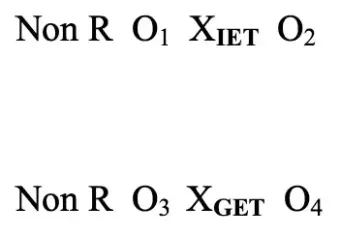
Non R = non-random X = treatment O = Dependent Variables
Heppner, Kivlighan, and Wampold (1999) noted that if a comparison is between two active treatments, a control group is not needed. The qualitative questions were analyzed using phenomenological procedures (Creswell, 1998) of horizonalization, textural description, structural description, and a summative composite description.
Research Questions
The overall quantitative research question was as follows: Does NILD GET, compared with NILD IET, affect the reading and writing skills of children with reading problems? Two specific questions,
representing this overall question are presented in the Results section. The overall qualitative question was as follows: What are the therapists’ perceptions about the effectiveness and characteristics of the two therapy settings investigated in this study? To explore the answer to this overall question, the nine GET therapists were asked to write comprehensive answers to six open-ended questions.
Intervention Treatment
The primary educational therapy techniques for IET and GET consisted of five core techniques designed to remediate diagnosed visual, auditory, and cognitive processing weaknesses plus visual- motor integration deficits. A description of these core therapy techniques is included under Qualitative Findings.
Test Instruments
The Woodcock Johnson III Tests of Achievement (WJ III ACH; Woodcock, McGrew, & Mather [2001a]) were used to measure academic ability in the study. IQ scores were derived from the Wechsler Intelligence Scale for Children, Fourth Edition (WISC-IV; Wechsler, 2003) or the Woodcock-Johnson III Tests of Cognitive Ability (WJ III-COG; Woodcock, McGrew, & Mather, 2001b).
Data Collection
Data collection occurred prior and subsequent to the implementation of IET or GET, which was given over a period of one school year (50 to 60 sessions of 80 minutes’ duration each). GET therapy was given either in 2007-2008 or 2008-2009. IET therapy was given in 2006-2007. Initially, written answers for six qualitative questions were collected. Opportunity for expansion and clarification of these answers came in the form of e-mail or phone communications.
Data Analysis Procedures
To answer the overall and the specific quantitative questions of this study, the WJ III ACH composite scores, Broad Written Language (BWL) and Broad Reading (BR)—and their respective component scores, Spelling (Sp), Word Identification (WI), Passage Comprehension (PC), Reading Fluency (RF), and Writing Samples (WS)—were compared using within-group and between-group t tests. Unless otherwise noted, statistical significance was set at alpha = 05.
Data analysis in phenomenology utilizes a methodology of reduction in which analysis of specific statements becomes a search for the central underlying meanings of the participants’ experience of a phenomenon (Creswell, 2003). Statements in the interviews revealed how the GET therapists perceived their new task of implementing GET versus IET. Horizontalization of the data developed a list of non- repetitive statements that were grouped into “meaning units” (Creswell, 1998). From these units, a textural description included verbatim statements. Next, a structural description sought to include all possible meanings and divergent perspectives. Finally, a composite description sought to summarize the therapists’ experience of switching from IET to GET. Validation of the structural and composite descriptions was then secured from GET therapists.
Results
Description of the Participants
The IET student sample (n = 39) was drawn from a two-year study of Keafer (2008). Prior to enrollment, students demonstrated standard scores < 89 in Broad Reading and/or Broad Written Language (WJ III ACH; Woodcock, McGrew, & Mather, 2001.) Keafer’s one-year raw data was used by permission in this study. For the GET student sample (n = 34), the selection criterion of a standard score < 93 (i.e. the lower 1/3 in achievement) was chosen for pre-intervention reading and/or written language scores in order to achieve statistical power of at least 30 participants. Furthermore, both the IET and GET groups had identical percentages of elementary (59 %) and upper school (41%) students. The GET and IET groups did not participate in other interventions for reading or written language weaknesses.
Quantitative Findings
Question 1: What are the effects of NILD GET compared to NILD IET on the Broad Written Language (BWL) and the Broad Reading (BR) scores of the WJ III ACH?
Between-group t tests were conducted to check if there were any differences in mean pre- and post intervention BR and BWL scores of the WJ-III ACH of the GET and IET groups. There were no significant differences. However, the mean IQ of the GET group was significantly lower that the mean IQ of the IET group, M = 7.45, t (70) = 3.33, p = .001, eta-square = .14. (Small, medium, and large effect sizes for eta-square are traditionally set at .01, .06, and .14, respectively [Green, Salkind, & Akey, 2000]).
Within-group t tests were used to evaluate changes in composite reading and writing skills within the GET and IET groups. Both groups demonstrated statistically significant, large post-intervention gains, with the IET Group having the larger effect sizes (ESs). However, a pattern noted in the GET group raw data led to the division of the GET group. There were GET subgroups that maintained pre-intervention levels of achievement but made no significant posttest gains in composite reading or
writing; however, these GET subgroups entered therapy with their respective composite mean reading or writing skills already significantly above their mean IQ.
Between-group t tests between the two GET reading subgroups showed significant differences between their mean IQ scores but not between their mean pre-BR scores, or between their mean post BR scores. The mean difference in IQ between the two GET reading subgroups was 10.93, t (31) = 3.16, p = .004, eta-square = .24. Between-group t tests between the two GET writing subgroups showed significant differences between their mean IQ, M = 11.27, t (31) = 3.40, p = .002, eta-square = .28, and their mean pre-BWL standard scores M = 10.88, t (31) = 2.86, p = .007, eta-square = .21. However, there was no significant difference between the means of the post-BWL standard scores of the two GET writing subgroups. Table 1 reports the mean pre-and post-intervention composite reading and writing scores along with mean IQ scores for these respective groups.
Table 1. Mean IQ and WJ III ACH Broad Reading and Broad Written Language Scores for GET and IET Groups

Note. Mean scores are based on standard scores. GET = Group Educational Therapy; IET = Individual Educational Therapy. IQ denotes the Full Scale Intelligence Quotient from either the Wechsler Intelligence Scale for Children, Fourth Edition (WISC IV; 2003) or the Woodcock Johnson III Tests of Cognitive Abilities (WJ III-COG; 2000). aGET denotes GET subgroup (57% elementary students; 43% upper school students) with its mean IQ score significantly above its mean Pre-BR score. bGET denotes GET subgroup (50% elementary students; 50% upper school students) with its mean Pre-BR score significantly above its mean IQ score. cGET denotes GET subgroup (67% elementary students; 33% upper school students) with its mean IQ score significantly above its mean Pre-BWL score. dGET denotes GET subgroup (47% elementary students; 53% upper school students) with its mean Pre-BWL score significantly above its mean IQ score. eBR denotes Broad Reading composite score from WJ III ACH. fBWL denotes Broad Written Language composite score from WJ III ACH.
Between-group t tests showed that the mean IQ of the GET subgroups which made significant post-BR and BWL gains had no significant difference compared to the mean IQ of the IET group, M = 3.57, t (58) = 1.58, p = .120, eta-square =.04; and M = 2.33, t (55) = .98, p = .329, eta-square = .02 respectively. Unlike the full GET group, 96% of the IET participants began educational therapy with both their pre-reading and writing standard scores either moderately lower (< 15) or severely lower (> 15) than their respective IQs.
Within-group t tests showed that the GET subgroup whose mean IQ was statistically significantly above its pre-BR score made greater gains in reading compared to the full GET and IET groups as evidenced by larger effect sizes. The GET subgroup whose mean IQ was significantly above its mean pre-BWL score made greater gains in writing than the full GET group but did not achieve as great a gain in writing as the IET group. Table 2 reports the gains in Broad Reading and Broad Written Language made by the full GET, partial GET, and IET groups.
Table 2. Mean Gains in Broad Reading and Writing Skills for GET, Partial GET, and IET Groups
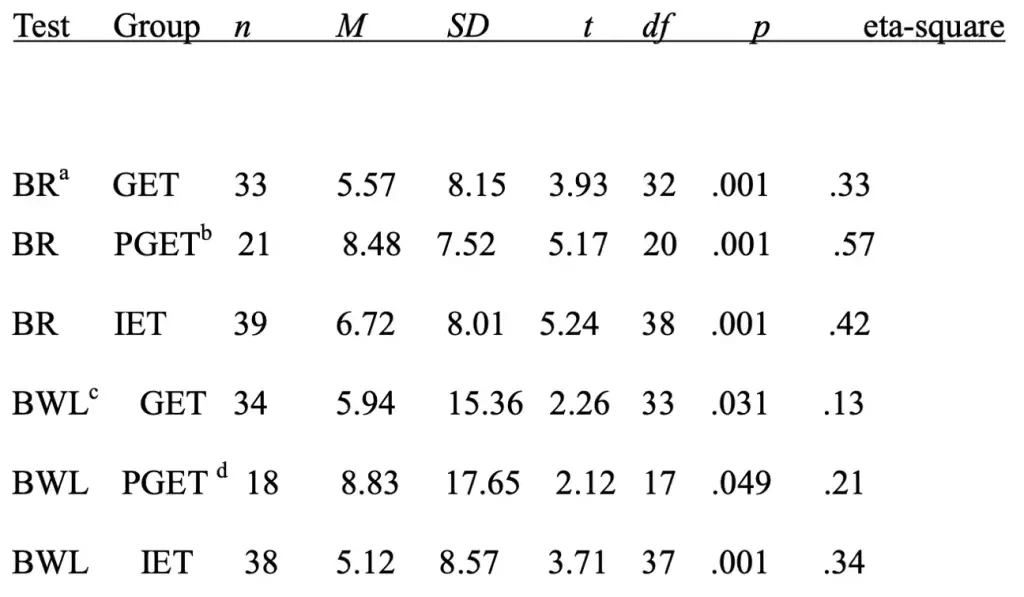
Note. Mean scores were based on standard scores. GET = Group Educational Therapy; IET = Individual Educational Therapy. aBR denotes Broad Reading composite score from WJ III ACH. bPGET denotes GET subgroup with its mean IQ score significantly above its mean BR score. cBWL denotes Broad Written Language composite score from WJ III ACH. dPGET denotes GET subgroup with its mean IQ score significantly above its mean Pre-BWL score.
Question 2. On which specific reading and written language skills, as measured by five subtests of the WJ III ACH (Word Identification, Reading Fluency, Passage Comprehension, Spelling, and Writing Samples) do students with reading problems make the most progress as a result of GET, compared with those who had IET?
Comparative statistical data for IET, GET, partial GET with IQ above pre BR, and partial GET with IQ above pre BWL groups is included in this analysis. It does not include data from the GET subgroup with pre-Broad Reading (BR) above IQ or the GET subgroup with pre-BWL above IQ. Just as these two GET subgroups showed no respective post-intervention gains in composite reading and writing skills, they showed no respective posttest gains in any of the component skills. Tables 3 and 4 report the pre- and post intervention scores of WJ III ACH reading and writing subtests for the IET, GET, and partial GET groups with mean IQ significantly above their respective mean pre-BR and/or pre-BWL.
Table 3. Mean WJ III ACH Reading Subtests Scores for Partial GET, GET, and IET Groups
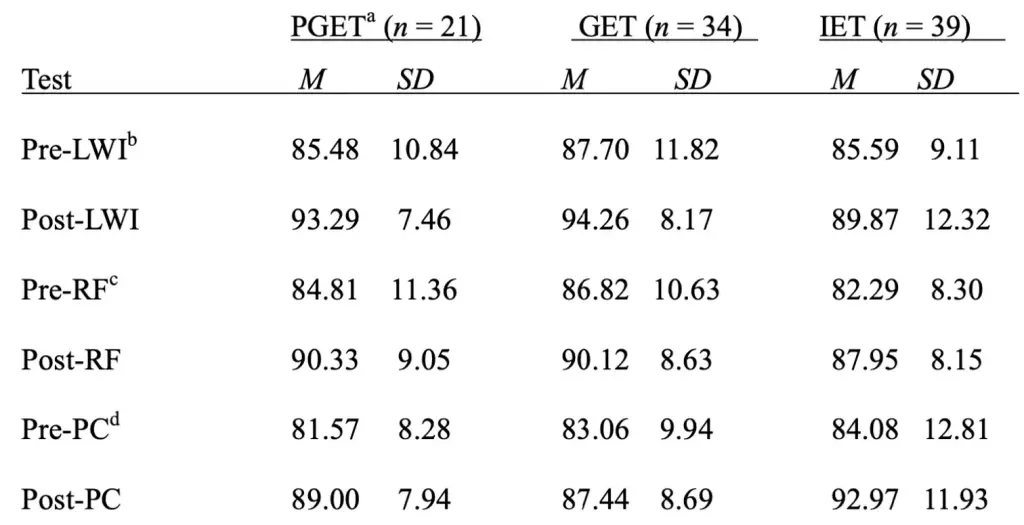
Note. Mean scores were based on standard scores. GET = Group Educational Therapy; IET = Individual Educational Therapy. aPGET denotes GET subgroup with its mean IQ score significantly above its mean pre-BR score. bLWI denotes Letter Word Identification subtest score from WJ III ACH. cRF denotes Reading Fluency subtest score from WJ III ACH. dPC denotes Passage Comprehension subtest score from WJ III ACH.
Table 4. Mean WJ III Writing Subtests Scores for Partial GET, GET, and IET Groups
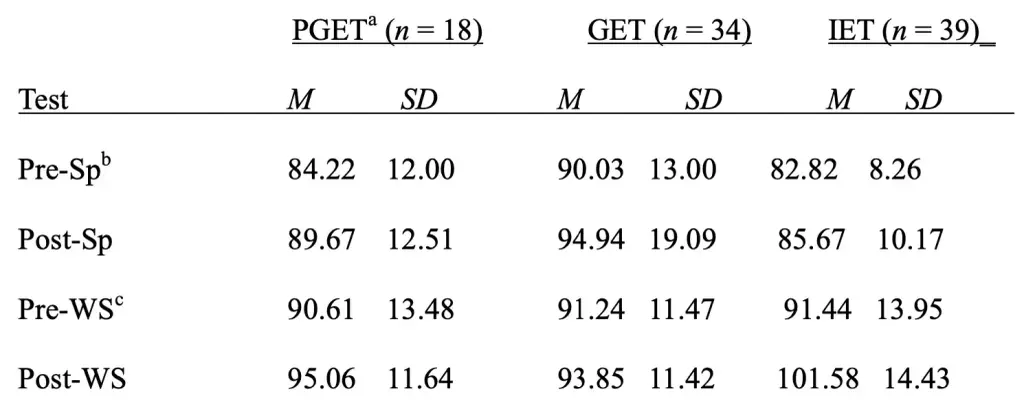
Note. Mean scores were based on standard scores. GET = Group Educational Therapy; IET = Individual Educational Therapy.
aPGET denotes GET subgroup with its mean IQ score significantly above its mean pre-BWL score. bSp denotes Spelling subtest score from WJ III ACH.
cWS denotes Writing Samples subtest score from WJ III ACH.
Table 5 reports results of within-group t tests for the IET group, full GET group, and GET subgroup whose mean IQ score was significantly above its mean pre-intervention component reading scores. Large gains were made by full GET, GET subgroups, and the IET group in all reading subtests.
However, effect size values demonstrate larger effects of GET for the partial GET group with IQ above BR compared to the effect of GET on the component reading skills of the full GET group. For the sample used in this study, the larger effect sizes for the partial GET compared to IET indicate a stronger effect on measured reading skills when NILD Educational Therapy was implemented in a GET setting compared to an IET setting.
Table 5. Mean Gains in Component Reading Skills for GET, Partial GET, and IET Groups
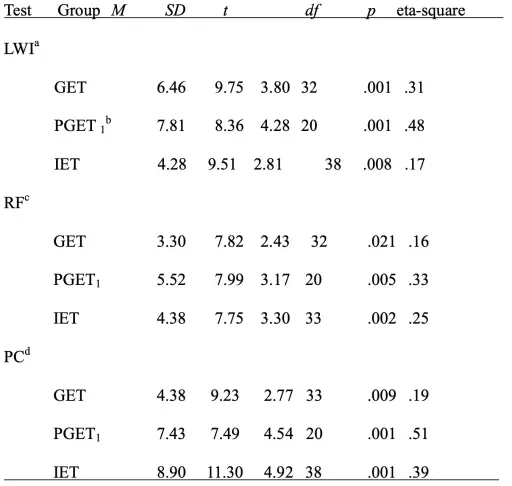
Note. Mean scores were based on Standard Scores. GET = Group Educational Therapy; IET = Individual Educational Therapy.
aLWI denotes Letter Word Identification subtest score from WJ III ACH. bPGET1 denotes subgroup with its mean IQ score significantly above its mean Pre-BR score. cRF denotes Reading Fluency subtest score from WJ III ACH. dPC denotes Passage Comprehension subtest score from WJ III ACH.
Table 6 reports results of within-group t tests for the IET, full GET, and partial GET groups in component writing skills. Gains in Spelling (Sp) were significant at alpha = .10, but not at alpha = .05 for the partial GET and IET groups. Although neither the full GET nor the partial GET group made any significant gains in the Writing Samples (WS) subtest, the scores of Sp and WS did combine to produce significant gains in the composite BWL for both the full GET and the partial GET (as seen in Table 4). Only the IET group had a significant, large gain in the WS subtest. For the sample used in this study, the larger effect size for the IET group compared to the full and partial GET groups indicate a stronger effect on measured writing skills when therapy was implemented in an IET setting compared to a GET setting. However, for the partial GET group, the GET setting yielded a greater effect on Sp than the IET setting.
Table 6. Mean Gains in Component Writing Skills for GET, Partial GET, and IET Groups
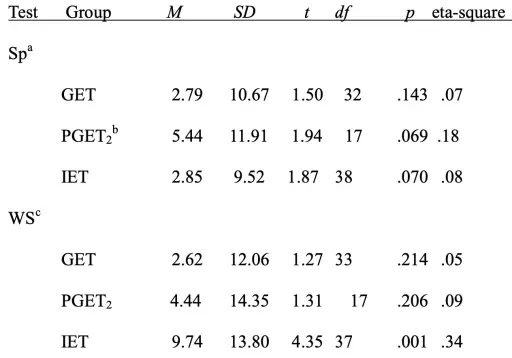
Note. Mean scores were based on standard scores. GET = Group Educational therapy; IET = Individual Educational Therapy.
aSp denotes Spelling subtest score from WJ III ACH. bPGET2 denotes GET subgroup with its mean IQ score significantly above its mean Pre BWL score. cWS denotes Writing Samples subtest score from WJ III ACH.
Qualitative Findings
The overall qualitative research question was as follows: What are therapists’ perceptions about
characteristics and effectiveness of the two therapy settings investigated in this study? To explore the answer to this overall question, nine GET therapists provided responses to six open-ended questions. Representative textural answers to each question follow.
Question 1. What criteria would you use to place students in GET versus IET?
All GET therapists mentioned consideration of similarity as well as severity of deficits as a primary consideration in placing a student in either a GET or an IET setting. Severity and number of deficits were cited as reasons to place students in an IET setting rather than in a GET setting. The consensus was that GET groups should include less severely deficit students whose reading and writing deficits were as closely matched as possible. Matching GET students by grade was also done.
Question 2. Please compare your experiences in implementing the following four techniques in a GET versus an IET setting: Rhythmic Writing, Blue Book, Dictation and Copy, and Buzzer. A textural description of therapist perceptions as well as a brief description of the techniques themselves follows.
Rhythmic Writing (RW) technique. RW leads to improved handwriting, attention, and performance on intermodal tasks through tracing and verbalizing counts of various figure eights and alphabetic motifs on a chalkboard. Therapist B wrote, “I am amazed at the challenge that occurs when you have to keep pace with your peers. I believe GET RW challenges areas we did not reach in IET.” Therapist G added, “The self-regulation that must take place to maintain the pace set by a leader and to focus on the whole group brought much progress in and outside the classroom for attention. They learned the techniques faster than IET students and made greater gains because of their self-evaluation/peer-evaluation of work.”
Therapist E experienced resistance from some GET participants and offered the following explanation: “Some students did not feel a need for RW due to already having good cursive handwriting and would resist synchronizing with other GET students in the group.” Therapist F wrote, “This [RW] definitely takes longer to master and all the separate components have to be added as the group as a whole is able to reach mastery.”
Blue Book (BB) technique. The Blue Book Method (Dwyer, 2000) provides systematic instruction in phonics and their graphemes. Therapists B stated, “Home preparation and working in front of your peers provides an excellent opportunity for motivation between students.” Therapist G wrote, “This technique is much more fun in a group setting vs. IET.” She went on to explain that competition fostered focus, defense of answers, increase in processing speed, discussions of strategies for “keeping up,” and application to note-taking in the classroom. Therapist B gave the following specific example, “Students made gains in spelling and syllabication on which the therapist often did not specifically work directly but rather indirectly through BB memorization.” Therapist I worked with “older students on pages on the higher level of BB technique (i.e. common endings of multi-syllable words) and made application to written text and developing vocabulary.” Therapist H advised, “Review activities needed to be planned carefully to keep each one actively engaged.”
Dictation and Copy technique. In a therapy session, two sentences are dictated one at a time. Spelling, grammar, auditory recall and writing errors are corrected via a mediated learning experience. Copying, proofing, determining the main idea, and summarizing the paragraph are homework for the next session. GET therapists voiced many comments on the benefits of this technique in thinking and language stimulation. Therapists B, D, F, and G voiced similar comments to this one from Therapist F, “The dialogue factor for recall, and details is very powerful in GET.” An example was given by Therapist A, who wrote, “This is a good place to develop the skill of creating a group summary sentence answering the wh [why, when, where, what, who] questions.”
Difficulty in implementation of the techniques in a GET delivery system was noted by a number of the therapists. For example, Therapist B wrote that it was “very challenging for me to get responses from all students. If language is difficult, this is where they will hold back.”
Buzzer technique. Words are built one letter at a time using the Morse code. Lower-order skills (e.g. orthographic patterns and phoneme identification) and higher-order skills (parts of speech, morpheme units, and multiple meanings) are incorporated to stimulate language development. GET therapists’ perspectives clustered into three topical areas: benefits, necessary creative adaptations, and a downside. Therapist E wrote the following:
It was great how they could challenge each other with multi-meanings, multi-parts of speech and extensions on sentence length/structure. They had to allow each other think time and to really listen to each other’s responses. The IET students did not have the richness of learning from others; however, they do have the richness of having to expand their thinking without just letting someone else add it to their thoughts or ideas.
Question 3. How well-matched in cognitive/perceptual, academic strengths and deficits were the individual students making up your GET groups? How did you handle students’ mismatches? All but one therapist stated they sought to compose GET groups with as closely matched reading and writing deficits as possible. Positive affective interactions in the GET delivery system were noted as being essential to creating a “safe environment” for learning. Numerous examples were cited.
Question 4. What specific peer tutoring activities or cooperative learning activities did you facilitate in GET? How regularly did such activities occur?
Seven of nine therapists used the term peer mediation or gave examples of it occurring during therapy. Therapist B wrote, “Peer mediation was a built in feature of GET that allowed it to be very different than IET...”
Question 5. What were the most difficult aspects of transitioning from years of implementing IET to implementing GET?
Five therapists named the issue of extended time needed to complete techniques. Therapist E stated, “The IET allows opportunity to just move on; therefore, we are able to accomplish a greater variety of techniques during the session.” Extended time was required to plan each GET session. Therapist I wrote, “The most difficult aspect of GET is that the planning is very time consuming and deliberate.” Six therapists cited maintaining individualized intervention that was appropriate to various deficits of individual members of the GET group as being very difficult.
Therapist B found that allowing a session to be “student-response led” was the hardest thing for her: “This is uncomfortable and unpredictable but it gives the most success. Be quick on your feet and believe in mediation. I am still amazed at the gains my students made that were not about my intentional planning but more about my intentional guiding in session.”
Question 6. What recommendations would you have for future training sessions of GET therapists? The difficulties encountered by GET therapists often resurfaced in the recommendations for future training sessions. Therapist A wrote, “Be sure to have one planning period for every GET session you have.” Regarding practice runs of GET therapy, Therapist A wrote, “Observe an actual GET session with students vs. just adult therapists in GET training.” “Our training sessions did provide some excellent ideas for keeping all involved ...as well as demonstrated in our group practice. Perhaps additional practice sessions and demonstrations would be advantageous due to an extensive variety of ideas needed when working with more students at once,” (Therapist H). Therapist C wrote, “The instructors trained us well, but until you have a group of students you never really know what to expect. My one piece of advice would be—‘Be Flexible.’ ”
From the textural descriptions, a structural description was formulated that answered the overall qualitative question: What are the therapists’ perceptions about the effectiveness and characteristics of the two therapies investigated in this study?
Integrity of NILD educational therapy techniques was maintained while allowing for individualization of the technique to varying needs of the students in GET. Unique personality traits of each therapist seemed to factor into her perception of ease or difficulty of implementing various techniques in either GET or IET. Very conscientiously, they evaluated and adapted the NILD techniques to the complexities of a small-group setting. GET therapists understood and took on the challenge of the affective social components of small-group as reflected in this statement by Smith (2009, p.11):
I have found that leading a GET session is much like directing an orchestra; there are variations of tempos, with multiple climactic moments. However, every person needs to feel safe enough within the group to explore the potential to be seen as “not being smart.” As one parent said, “My daughter knows that it’s okay not to have the right answer every time. The wrong answer does not make her feel bad but just the opposite—it challenges her to get it right.” ... Critical to GET is the aspect of keeping everyone’s attention throughout group therapy sessions. This component has proven to be the most challenging. Every group member needed to be what I call “detectives” within a session.
A composite description was the final step in the phenomenological analysis of GET therapists’ perceptions of transitioning from IET to GET. As expressed by GET therapists, advantages of the IET setting were in dealing more effectively with following: (a) very severe deficits, (b) getting more techniques done in a session, and (c) addressing an individual’s specific deficits in greater depth. Advantages of the GET setting were the following: (a) a friendly competitiveness that increased processing speed, (b) consequent enrichment of language as a result of peer mediation, cooperative, and collaborative learning tasks, and (c) self-regulation and appropriate social interactions mediated in GET. Further characteristics that differentiated GET from IET were the following: (a) more intensive planning required for GET, and (b) intensive vigilance was required to facilitate, mediate, and monitor GET.
The structural and composite descriptions were e-mailed to three GET therapists with 7, 9, and 19 years of experience in doing NILD IET. They confirmed the validity of the two descriptions.
Discussion
Comparative Significance of Results
The findings in this research study have relevancy to the findings of a meta-analysis conducted by Swanson and Hoskyn (1998) of treatment outcomes from interventions implemented with students with LD. Swanson and Hoskyn found several interesting methodological variables that affected the magnitude of effect size (ES) of the dependent variables in those 180 studies. Calculation of ES was for Cohen’s d in which .8, .5, and .2 traditionally represent large, medium, and small ESs, respectively (Green et al., 2000). Patterns found that apply to this research study are as follows:
- Studies in which treatment occurred outside the classroom yielded significantly larger ESs than those in the classroom.
- Studies that relied on experimental measures rather than standardized measures for the dependent variable yielded significantly higher ESs. For example, in reading comprehension, the mean d for standardized test measures was .45 as opposed to a mean d of .84 for experimental test measures.
- The relationship between a mean pre-intervention reading score and a mean IQ of a group was termed IQ X Reading Severity interaction and affectedcESs categorically. IQ X Reading Severity produced the highest ESscwith relatively small discrepancies between IQ and initial reading (i.e. IQ between 84 and 91 and reading scores between 84 and 91) compared to studies reporting IQ > 91 and reading scores between 84 and 91. Studies with the lowest ES were those which reported reading scores higher than IQ (reading score > 90, IQ between 84 and 90).
- Sample size affected ES of treatment outcome. Sample sizes of less than 25 yielded larger ESs, average Cohen’s d = .77, than sample sizes between 25 and 50, average Cohen’s d = .55.
The partial GET groups in which the mean pre-BR or pre-BWL was significantly above its mean IQ and which made no significant gains in posttest reading or writing scores align with what Swanson and Hoskyn (1998) found in the studies they analyzed.
Treatment outcomes for GET, IET, and partial GET compare quite favorably with the mean ESs reported for the various standardized reading and writing skills analyzed in Swanson and Hoskyn’s (1998) report. The IET mean difference between IQ and pre-BR represented a broad discrepancy, M =14.69, SD = 7.35, yet the full IET group achieved large ESs in Writing Samples and Passage Comprehension. The partial GET group also had a larger spread between IQ and pre-Broad Reading, M = 10.8, SD = 9.30, than the condition Swanson and Hoskyn (1998) found to yield the largest ESs. In other words, it appears GET and IET were effective for increasing reading and writing skills even when there were large IQ X Reading Severity differences.
In addition, the ESs of the IET group (n =39) in general reading (d = .89), reading comprehension (d =.79), and writing (d = .71) were closer to the mean ES (d = .77) found for smaller sample sizes (< 25), than for the mean ES (d = .55) found for larger sample sizes (25 to 50) in Swanson and Hoskyn’s (1998) study. This fact speaks well of the research results for the IET group (n = 39) in this study. Table 7 compares the weighted and unweighted (in regard to sample size of a study) mean ESs for standardized test outcomes from Swanson and Hoskyn’s (1998) study with mean ESs for comparable standardized test outcomes for full GET (n = 34), partial GET (n = 20 or n = 18), and IET (n = 39) groups investigated in this research.
Table 7. Comparison of GET, Partial GET, and IET Effect Sizes with Average Effect Sizes of Swanson and Hoskyn’s (1998) Meta-Analysis for Various Reading and Writing Skills
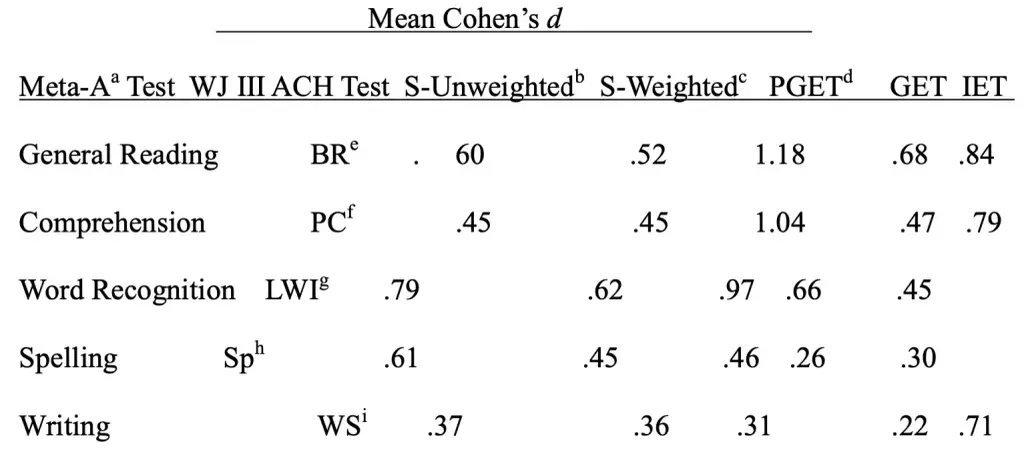
Notes. Cohen’s d reported is for studies with standardized test score means except for General Reading, which is a composite effect size for both experimental and standardized test measures. GET = Group Educational Therapy; IET = Individual Educational Therapy.
aMeta-A denotes meta-analysis score from Swanson and Hoskyn’s (1998) study. bS-Unweighted denotes unweighted for sample size in Swanson meta- analysis. cS-Weighted denotes weighted for sample size in Swanson meta-analysis. dPGET denotes subgroup (n = 20) with Pre-BR score below IQ or GET subgroup (n = 18) with Pre-BWL score below IQ. eBR denotes Broad Reading composite score from WJ III ACH. fPC denotes Passage Comprehension subtest score from WJ III ACH. gLWI denotes Letter Word Identification subtest score from WJ III ACH. hSp denotes Spelling subtest score from WJ III ACH. iWS denotes Writing Samples subtest score from WJ III ACH.
It should be noted that the average length of treatment for studies included in the meta-analysis of Swanson and Hoskyn (1998) was much shorter (average of 13 hours over a 10-week period) than the average length of the NILD interventions (82.5 hours over the full school year). However, Swanson and Hoskyn note that maintenance of gains when follow-up research has been done is usually very poor or non-existent. However, three years after completion of NILD IET, a previous study by Bensen and Scott (2005) demonstrated maintenance of academic gains. The study involved 55 of 114 students who could be located and retested. The possibility that maintenance of academic skills is due to longer, sustained interventions, which are a characteristic of NILD Educational Therapy, should be considered and investigated further with GET and IET students.
Limitations
A limitation to this study may be the lack of random sampling. Since the GET therapy was a pilot study, the student group that was obtained is best described as a convenience sample. The IET sample was also non-random as finding a sample of IET students with below-average achievement from among 4,000 NILD students who were primarily (97%) enrolled in Christian college preparatory schools was a challenge. Limiting participation to only certified educational therapists also limited the number of eligible student participants; however, another potential limitation due to the possibility of variation in effectiveness of the educational therapist was minimized by selecting only certified education therapists.
Conclusion and Implications for Practice
Whether in a GET or IET setting, NILD Educational Therapy, mediated by professionally certified therapists, yielded improved reading skills with large effect sizes (eta-square) for full IET, full GET, and partial GET groups, except for the GET subgroups that began therapy with their mean pre- intervention reading or writing scores already significantly above their respective mean IQ. The analyses of scores of various GET subgroups evidenced an effectiveness of therapy that crossed grade- level differences and various IQ X Reading Severity categories.
In addition, both the quantitative and qualitative findings gave very concrete evidence that the theories of Vygotsky and Feuerstein (Hopkins, 2010) that are the theoretical underpinnings of NILD Educational Therapy were actually put into practice by both the GET and IET participants of this study. The qualitative phase of the study also clearly explains differences in implementation of GET therapy compared to IET therapy and provides seasoned advice to future GET therapists. Combined review of the quantitative and qualitative findings of this research brings one to the conclusion that GET therapy is neither for the novice therapist nor the “faint of heart.” Exploration to improve writing skills in a GET setting has already been undertaken and applied to training courses subsequent to the dates of this research.
Connie Cawthon, PhD, is an educational therapist at the Master’s Academy in Oviedo, FL. Her research study summarized here was done under the guidance of Dr. Joseph Maddox, her Doctoral Committee Chair. Connie may be reached at her e-mail: cawthon_j@bellsouth.net.
Joseph Maddox, DC, PhD, is an assistant professor in the Organizational Learning and Leadership department within the Adrian Dominican School of Education at Barry University in Miami Shores, FL. Joseph may be reached through his email: jmaddox@mail.barry.edu.
References
Aaron, P. G., Joshi, R. M., Gooden, R., & Bentum, K. E. (2008). Diagnosis and treatment of reading disabilities based on the Component Model of Reading: An alternative to the discrepancy model of learning disabilities. Journal of Learning Disabilities, 41, 67-84.
Bensen, B., & Scott, K. (2005). Data analysis to determine the effectiveness of NILD educational for students with learning disabilities. Retrieved August 16, 2008.
Creswell, J. W. (1998). Qualitative inquiry and research design: Choosing among five traditions. Thousand Oaks, CA: Sage.
Creswell, J. W. (2003). Research Design: Qualitative, quantitative, and mixed methods approaches (2nd ed.). Thousand Oaks, CA: Sage.
Crockett, J. B. (2002). Special education’s role in preparing responsive leaders for inclusive schools. Remedial and Special Education, 23, 157-168.
Dwyer, K. (2000). The blue book method: An associative key word approach. Hilton Head, SC: Interactive Educational Systems, Inc.
Edwards. P. A., McMillon, G. T., & Turner, J. D. (2001). Whom are you teaching? Coordinating instructional networks around the students and the parents we serve. Reading Teacher, 55, 146- 150.
Gersten, R., Fuchs, L. S., Williams, J. P., & Baker, S. (2001). Teaching reading comprehension strategies to students with learning disabilities: A review of research. Review of Educational Research, 71, 279-320.
Green, S. B., Salkind, N. J., & Akey, T. M. (2000). Using SPSS for Windows: Analyzing and understanding data (2nd Ed.). Upper Saddle River, NJ: Prentice Hall.
Gresham, F. M., & Vellutino, F. R. (2010). What is the role of intelligence in the identification of specific learning disabilities? Issues and clarifications. Learning Disabilities Research and Practice, 25(4), 194-206.
Hallahan, D. P. (2007). Learning disabilities: Whatever happened to intensive instruction? LDA Newsbriefs, 42(1), 1-4.
Heppner, P. P., Kivlighan, D. M., Jr., & Wampold, B. E. (1999). Research design in counseling (2nd ed.). Belmont, CA: Wadsworth Publishing Company.
Hopkins, K. R. (1996). A study of the effect of interactive language in the stimulation of cognitive functioning for students with learning disabilities. Unpublished doctoral dissertation, The College of William & Mary, Williamsburg, VA.
Hopkins, K. R. (2010). Teaching how to learn in a what-to-learn culture. San Francisco, CA: Jossey- Bass.
Individuals with Disabilities Education Act (IDEA) Amendments of 1997, PL 105-17, 105th Cong. 1st Sess. (1997), from http://www.ed.gov/offices/OSERS/IDEA
Kavale, K. A., Holdnack, J. A., & Mostert, M. P. (2005). Responsiveness to intervention and the identification of specific learning disability: A critique and alternative proposal. Learning Disability Quarterly, 28, 2-16.
Keafer, K. (2008). Effects of National Institute for Learning Development educational therapy for students with learning difficulties. Unpublished doctoral dissertation, Regent University, Norfolk, VA.
Learner, J. W. (2000). Learning disabilities: Theories, diagnosis, and teaching strategies. Boston, MA: Houghton Mifflin Company.
Presseisen, G., & Kozulin, A. (1994). Mediated Learning: The contributions of Vygotsky and Feuerstein 28 in theory and practice. In M. Ben-Hur (Ed.), On Feuerstein’s instrumental enrichment: A collection (pp. 51-81). Palatine, IL: IRI/Skylight Training and Publishing, Inc.
Smith, M. (2008). Group educational therapy (GET), the “new kid” on the block: Can he get the job done? NILD Discoveries, 25(2), (pp. 10-14).
Stahl, S. A., & Yaden, D. B., Jr., (2004). The development of literacy in preschool and primary grade: Work by the Center for the Improvement of Early Reading Achievement. The Elementary School Journal, 105, 141-165.
Swanson, H. L. (2001). Research on interventions for adolescents with learning disabilities: A meta-analysis of outcomes related to higher-order processing. Elementary School Journal, 101, 331-348.
Swanson, H. L. & Hoskyn, M. (1998). Experimental intervention research on students with learning disabilities: A meta-analysis of treatment outcomes. Review of Educational Research, 68, 277- 321.
Vaughn, S., Hughes, M. T., Moody, S. W., & Elbaum, B. (2001). Instructional grouping for reading for students with LD: Implications for practice. Intervention in School and Clinic, 3, 131-137.
Wechsler, D. (2003). Wechsler Intelligence Scale for Children, Fourth Edition. San Antonio, TX: The Psychological Corporation.
Woodcock, R. W., McGrew, K. S., & Mather N. (2001a). Woodcock-Johnson III Tests of Achievement. Itasca, IL: Riverside Publishing.
Woodcock, R. W., McGrew, K. S., & Mather N. (2001b). Woodcock-Johnson III Tests of Cognitive Ability. Itasca, IL: Riverside Publishing.